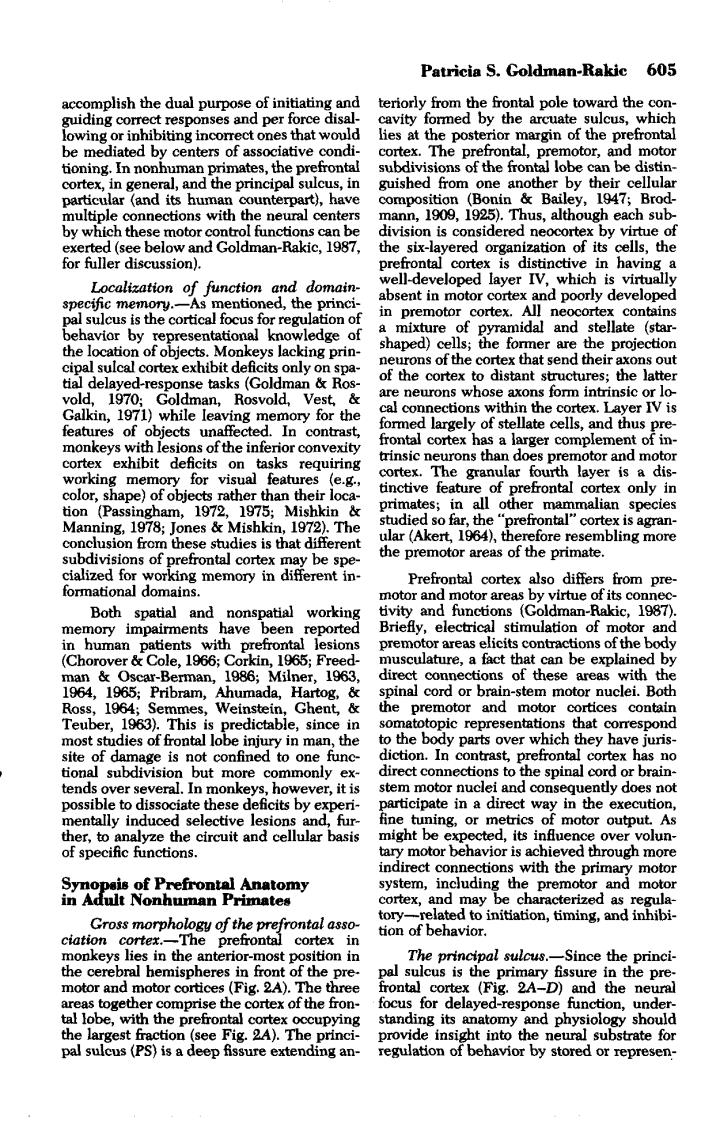正在加载图片...

Patricia S.Goldman-Rakic 605 mplish the dual purpose from the frontal pole toward the co per rgin of the media ted by centers of asso iative con The pr al otor. to guished fo of thef unterpa t).have ompo Bai 947 0 by which the ns can be the six-l ered orga ation of its ce h ssion IV. which is vir calization of function domain bsent in motor co tex d poorly develo the princ tational kno e 0 stellate the of th aeiayodre the latt se tasks (Gol 9 an svold neurons whose of of ste and thu contr has a l arge than for fea ar dis y )of o tinctive pre al ning,1978.7 ones Mishkin 1972).The th is that en fore re ombling more e prima cialized for not and irtue its Both aman-t elicits ions of the body ture, be 98 1964 Pribram ada 8&. cord or motor nuclei moto nost studie of fr in ma e the body tsover which thev haw to one e,iti tem tor nucle and conp p05 e to dissociate these icits by exp in a in the ther ze the be its n of spe of P efro system. the and moto lat ed to as hibi ciat tion of behavior. the in mos of the inc motor and motor cortices (Fig.2A) The three ig.2A-D) the ne its anato sto see Fig. 41 The prin the netrPatricia S. Goldman-Rakic 605 accomplish the dual purpose of initiating and guiding correct responses and per force disallowing or inhibiting incorrect ones that would be mediated by centers of associative conditioning. In nonhuman primates, die prefrontal cortex, in general, and the principal sulcus, in particuUir (and its human counterpart), have multiple connections with the neural centers by which these motor control Binctions can be exerted (see below and Goldman-Rakic, 1987, for friller discussion). Localization of function and domainspecific memory.—As mentioned, the principal sulcus is the cortical focus for regulation of behavior by representational knowledge of the location of objects. Monkeys lacking principal sulcal cortex exhibit deficits only on spatial delayed-response tasks (Goldman & Rosvold, 1970; Goldman, Rosvold, Vest, & Galkin, 1971) while leaving memory for the features of objects unaffected. In contrast, monkeys with lesions of the inferior convexity cortex exhibit deficits on tasks requiring working memory for visual features (e.g., color, shape) of objects rather than their location (Passingham, 1972, 1975; Mishkin & Manning, 1978; Jones & Mishkin, 1972). The conclusion from these studies is that different subdivisions of prefrontal cortex may be specialized for working memory in different informational domains. Both spatial and nonspatial working memory impairments have been reported in human patients with prefrorrtal lesions (Ghorover & Gole, 1966; Gorkin, 1965; Freedman & Oscar-Berman, 1986; Milner, 1963, 1964, 1965; Pribram, Ahumada, Hartog, & Ross, 1964; Semmes, Weinstein, Ghent, & Teuber, 1963). This is predictable, since in most studies of frontal lobe injury in man, the site of damage is not confined to one functional subdivision but more commonly extends over several. In monkeys, however, it is possible to dissociate these deficits by experimentally induced selective lesions and, further, to analyze the circuit and cellular basis of specific functions. SynomU of Prefrontal Anatomy in Adult Nonhnman Primates Gross morphology of the prefrontal association cortex.—The prefrontal cortex in monkeys lies in the anterior-most position in the cerebral hemispheres in front of the premotor and motor cortices (Fig. 2A). The three areas together comprise the cortex of the frontal lobe, widi die prefrontal cortex occupying the largest fraction (see Fig. 2A). The principal sulcus (PS) is a deep fissure extending anteriorly from the frontal pole toward die concavity formed by the arcuate sulcus, which lies at the posterior margin of the prefrontal cortex. The prefrontal, premotor, and motor subdivisions of the frontal lobe can be distinguished from one another by their cellular composition (Bonin & Bailey, 1947; Brodmann, 1909, 1925). Thus, although each subdivision is considered neocortex by virtue of the six-layered organization of its cells, the prefrontal cortex is distinctive in having a well-developed layer IV, which is virtually absent in motor cortex and poorly developed in premotor cortex. All neocortex contains a mixture of pyramidal and stellate (starshaped) cells; the former are the projection neurons of the cortex that send their axons out of the cortex to distant structures; the latter are neurons whose axons form intrinsic or local connections within die cortex. Layer IV is fonned largely of stellate cells, and thus prefrontal cortex has a larger complement of intrinsic neurons than does premotor and motor cortex. The granular fourth layer is a distinctive feature of prefrontal cortex only in primates; in all other mammalian species studied so far, the "prefix)ntal" cortex is agranular (Akert, 1964), therefore resembling more the premotor areas of the primate. Prefrontal cortex also differs from premotor and motor areas by virtue of its connectivity and functions (Goldman-Rakic, 1987). Briefly, electrical stimulation of motor and premotor areas elicits contractions of the body musculature, a fact that can be explained by direct connections of these areas with the spinal cord or brain-stem motor nuclei. Both the premotor and motor cortices contain somatotopic representations that correspond to the body parts over which they have jurisdiction. In contrast, prefrontal cortex has no direct connections to the spinal cord or brainstem motor nuclei and consequendy does not participate in a direct way in the execution, fine tuning, or metrics of motor output As might be expected, its influence over voluntary motor behavior is achieved throu^ more indirect connections with the primary motor system, including the premotor and motor cortex, and may be characterized as regulatory—related to initiation, timing, and inhibition of behavior. The principal sulcus.—Since the principal sulcus is the primary fissure in the prefrontal cortex (Fig. 2A-D) and the neural focus for delayad-response function, understanding its anatomy and physiology should provide insight into the neural substrate for regulation of behavior by stored or represen-